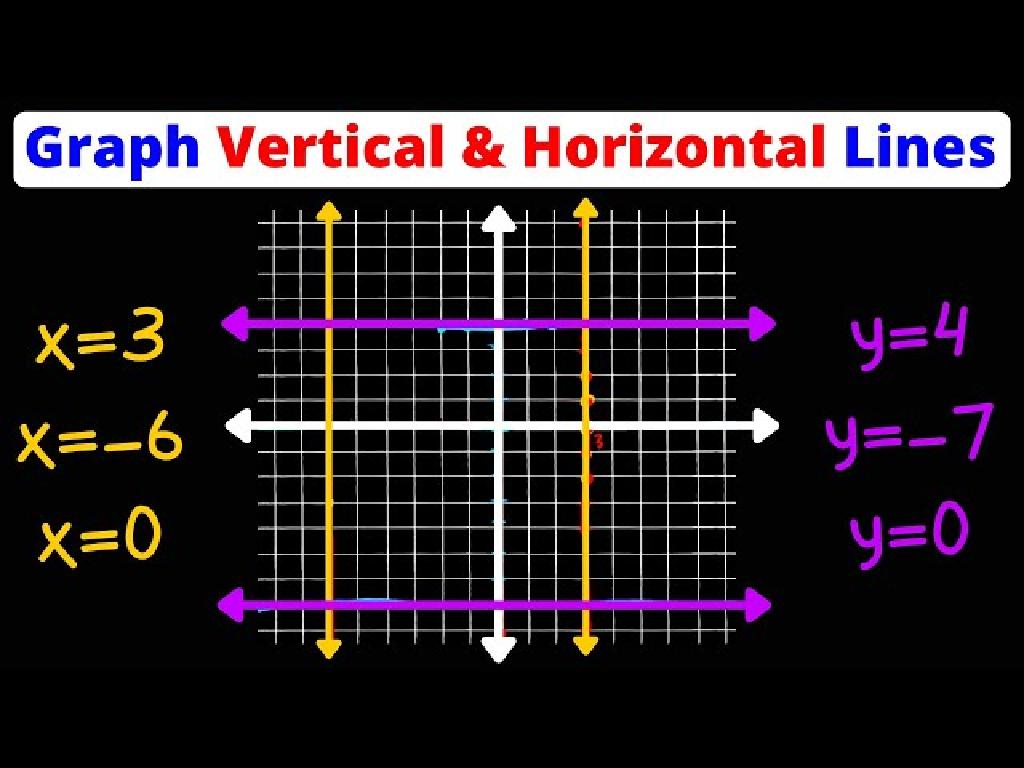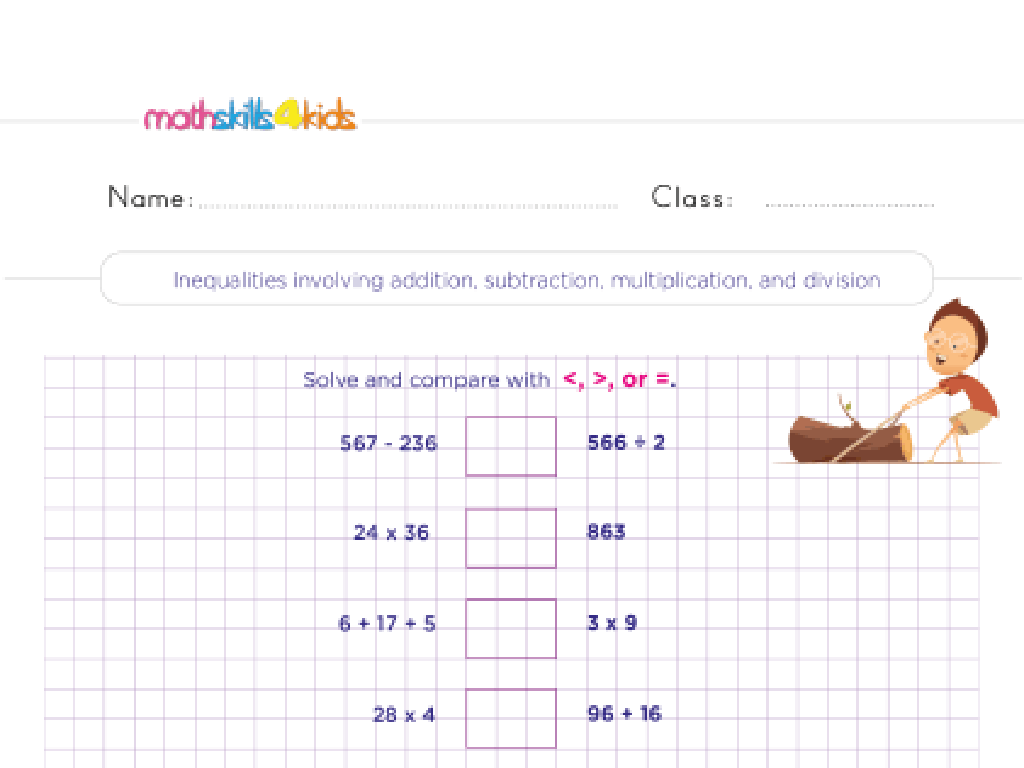Use Academic Vocabulary In Context: Informational
Subject: Language arts
Grade: Seventh grade
Topic: Context Clues
Please LOG IN to download the presentation. Access is available to registered users only.
View More Content
Mastering Academic Vocabulary with Context Clues
– Define academic vocabulary
– Specialized terms used in academic dialogue and texts
– Context clues reveal meanings
– Words or phrases surrounding unknown words help infer meaning
– Importance of context in reading
– Enhances comprehension and fluency in reading complex texts
– Strategies for using context clues
– Use definitions, examples, or restatements found near unfamiliar words
|
This slide introduces the concept of academic vocabulary, which refers to the specialized language used in educational settings. Emphasize the role of context clues hints found within sentences or paragraphs that help decipher the meanings of unfamiliar words. Discuss why understanding context clues is crucial for students: it aids in comprehending more challenging texts and expands their academic language proficiency. Offer strategies such as looking for definitions provided in the text, finding examples that illustrate the word, or identifying restatements that explain the term in simpler language. Encourage students to practice these strategies with various texts to become more confident readers and communicators in academic settings.
Understanding Context Clues
– Context clues: a definition
– Hints within text to define tricky words
– Explore the 5 types of clues
– Definition, Synonym, Antonym, Example, Inference
– Finding clues in text
– Look for clues within sentences and paragraphs
– Enhancing vocabulary skills
|
This slide introduces the concept of context clues, which are hints that authors provide to help readers understand the meaning of difficult or unusual words. It’s crucial for students to recognize the five types of context clues: definitions provided by the author, synonyms and antonyms that offer word comparisons, examples that illustrate the word in use, and inferences that require readers to draw conclusions based on the text. Teach students to actively look for these clues within sentences and paragraphs to improve their comprehension and vocabulary. Provide practice sentences for students to identify the type of context clue used and the meaning of the highlighted word.
Types of Context Clues
– Definition Clue: Direct explanation
– ‘Habitat, or the natural home of an animal, can vary widely.’
– Synonym Clue: Meaning through similar words
– ‘The arid desert, dry and barren, stretched before us.’
– Examples for each type
– Practice identifying clues
|
This slide aims to introduce students to the concept of context clues and how they can be used to determine the meaning of unfamiliar words in informational texts. The definition clue provides a straightforward explanation within the sentence, making it easier for students to understand new vocabulary. The synonym clue offers a similar word to the unfamiliar term, which can be identified by looking for commas or dashes that often separate the two. Provide examples for each type and then engage students in an activity where they identify context clues in sample sentences. This will help them apply the concept and improve their vocabulary skills.
Exploring More Types of Context Clues
– Antonym Clue: Understand opposites
– Words like ‘however’ or ‘unlike’ signal an opposite meaning.
– Example Clue: Learn from specifics
– Look for words like ‘such as’ or ‘for instance’ to find examples.
– Inference Clue: Read between the lines
– Use hints and background knowledge to guess meanings.
– Practice using different clues
|
This slide aims to deepen students’ understanding of context clues by focusing on antonym, example, and inference clues. Antonym clues use contrasting words to help define the unknown word. Example clues provide specific instances that illustrate the meaning of the word. Inference clues require students to use their prior knowledge and the information given around the word to deduce its meaning. Encourage students to practice identifying these types of clues in various texts. Provide exercises where they can apply these strategies to determine the meanings of challenging words, enhancing their vocabulary and comprehension skills.
Academic Vocabulary in Context
– Define academic vocabulary
– Specialized language used in academic settings
– Importance of academic vocabulary
– It’s key for understanding complex subjects
– Identify academic words in texts
– Look for subject-specific terms in examples
– Practice using academic vocabulary
– Use new vocabulary in sentences or summaries
|
This slide introduces students to the concept of academic vocabulary, which includes words and phrases that are commonly used in educational and professional settings. Understanding this vocabulary is crucial for students to grasp more complex subject matter and to communicate effectively in academic environments. Provide examples of academic vocabulary from various subjects and demonstrate how to identify these terms within the context of a text. Encourage students to practice using newly learned academic vocabulary by incorporating it into their own writing or discussions, which will help solidify their understanding and improve their ability to use these terms correctly.
Practice with Context Clues
– Read the given passage
– Highlight unfamiliar words
– Infer meanings using context
– Look for hints around the word that help explain its meaning
– Discuss inferred meanings
– Share and compare with classmates to understand different perspectives
|
This slide is designed to engage students in an activity that strengthens their ability to use context clues to determine the meaning of unfamiliar words. Students should first read the passage independently, highlighting any words they do not understand. Then, they should use context clues such as definitions, examples, synonyms, or antonyms provided in the surrounding text to infer the meanings of these words. Encourage students to consider the overall message of the passage and how each word contributes to that message. Afterward, facilitate a class discussion where students can share their inferences and learn from each other’s insights. This activity will help students become more autonomous readers and improve their comprehension of informational texts.
Group Activity: Context Clue Challenge
– Break into small groups
– Receive a paragraph with highlighted words
– Each group gets a unique paragraph
– Discuss and infer meanings
– Use context clues like synonyms, definitions within the text
– Write down your conclusions
|
This group activity is designed to enhance students’ ability to use context clues to determine the meaning of academic vocabulary. Divide the class into small groups to foster collaboration. Each group will receive a different paragraph containing several highlighted academic vocabulary words. The task for each group is to discuss and use context clues such as synonyms, definitions, examples, or explanations provided in the text to infer the meanings of the highlighted words. After the discussion, students will write down the inferred meanings to share with the class. For the teacher: Prepare diverse paragraphs with a range of academic vocabulary. Ensure each group has a mix of abilities to support each other. Possible activities: 1) Groups create their own sentences using the new words. 2) Groups draw illustrations representing the words’ meanings. 3) Groups use the words in a short story. 4) Groups prepare a mini-presentation on their paragraph. 5) Groups create a mini-quiz for other groups to answer.
Share and Reflect: Context Clues Exploration
– Groups present their findings
– Discuss varied interpretations
– How did context clues lead to different word meanings?
– Analyze context clue effectiveness
– Which types of context clues were most helpful?
– Reflect on best strategies
|
This slide is designed to facilitate a classroom discussion where students will share the outcomes of their group work on using context clues to understand academic vocabulary in informational texts. Each group will present their findings, followed by a class discussion on the different interpretations of words based on context. Encourage students to think critically about how context clues like synonyms, antonyms, definitions, and examples within the text helped them deduce meanings. The reflection part should focus on identifying which strategies were most effective for understanding new vocabulary. This will help students to develop metacognitive skills and become more autonomous learners. The teacher should guide the discussion, ensuring all groups have a chance to share and contribute to the conversation.
Class Activity: Crafting Sentences with Context Clues
– Write sentences with new vocabulary
– Embed clear context clues
– Use synonyms, definitions, or examples within your sentence to hint the meaning
– Individual sentence creation
– Class discussion on findings
– Share your sentences and explain the clues used
|
This activity is designed to enhance students’ understanding of using context clues to determine the meaning of new vocabulary. Each student will individually write sentences incorporating a new word they’ve learned, making sure to include context clues such as synonyms, definitions, or examples that help reveal the word’s meaning. After writing, students will engage in a class discussion to share their sentences and explain the context clues they used. This will not only reinforce their understanding of the words but also improve their ability to infer meaning from context. For the teacher: Prepare a list of new vocabulary words that students can choose from, ensure that students understand what context clues are, and guide the discussion to highlight effective use of context clues in their sentences.
Wrapping Up: Context Clues & Homework
– Review of context clues
– Academic vocabulary recap
– Homework: Article vocabulary hunt
– Find a newsworthy article, spot new terms, and deduce meanings from the surrounding text.
– Get ready to present findings
– Prepare to discuss how context helped you understand each word.
|
As we conclude today’s lesson, remind students of the importance of using context clues to understand academic vocabulary in informational texts. For homework, students should find an article on a topic of interest, identify at least five new academic words, and write down what they think each word means based on context clues. Encourage them to look for definitions within the text, synonyms, antonyms, or examples that provide insight into the word’s meaning. In the next class, students will share their findings, which will help reinforce their understanding and allow them to learn from each other’s discoveries.






